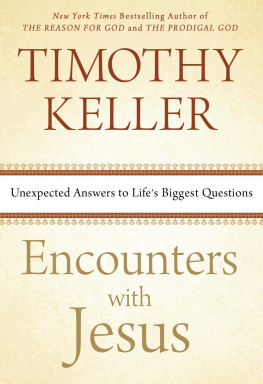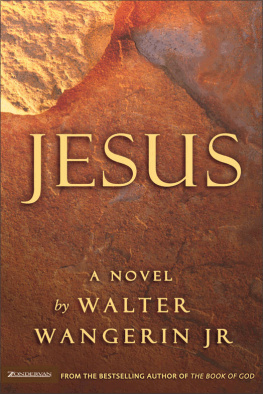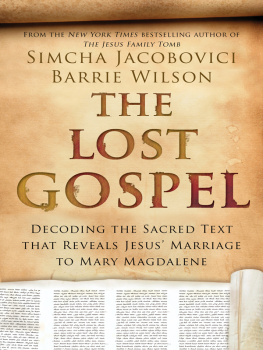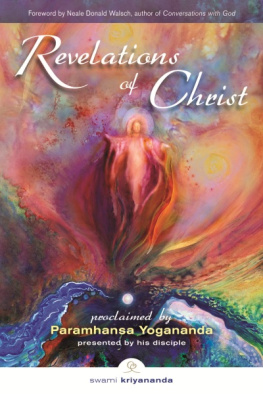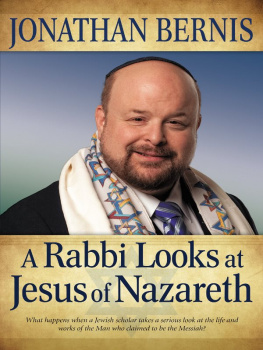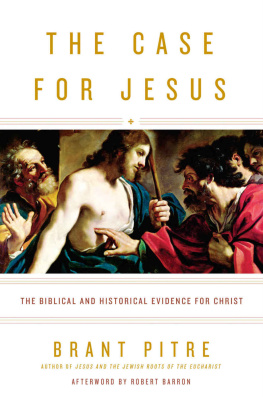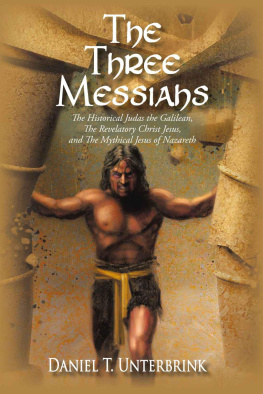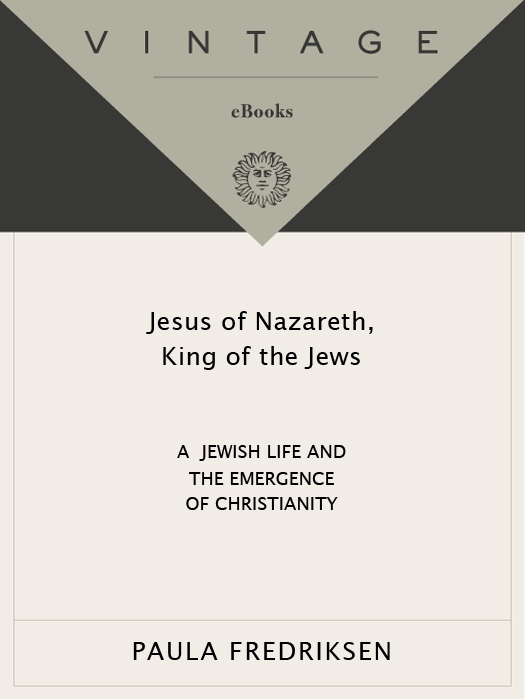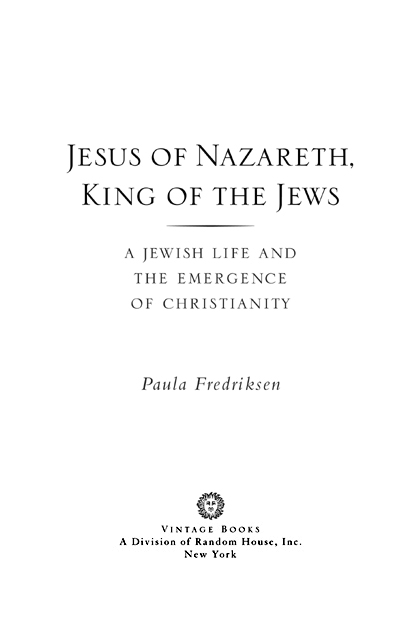Acclaim for Paula Fredriksens
J ESUS OF N AZARETH ,
K ING OF THE J EWS
Why was Jesus killed? Fredriksens search for an answer is almost a detective story refreshingly independent of dogma and cant.
The Atlanta Journal-Constitution
Fredriksens reconstruction of the events around the trial of Jesus is particularly brilliant. We can suddenly see why the Romans would decide he must become an object lesson for less disciplined Jews.
Providence Journal
Jesus of Nazareth, King of the Jews shows beyond any question Fredriksens mastery of her sources and a level of insight achieved by firm command of the analytical tools she brings to bear.
The Boston Book Review
Jesus of Nazareth invites a general readership to forget everything it has learned about Jesus and to begin again.
Mail on Sunday (London)
Fiercely argued put together with great perceptiveness.
The Daily Telegraph (London)
Fredriksen has made not only the world of first-century Palestine, but also the maze of Jesus scholarship, intelligible to lay readers.
Kirkus Reviews
Paula Fredriksen does a masterful job of conveying what it must have been like growing up in Jesus day.
The News & Observer (Raleigh)
The central question it asksWhy did Jesus die the way he did?strikes to the very core of the debate over the historical Jesus There is much new here.
Publishers Weekly
An important contribution to the vast and proliferating literature on the historical Jesus.
Booklist

Paula Fredriksen
J ESUS OF N AZARETH ,
K ING OF THE J EWS
Paula Fredriksen currently holds the William Goodwin Aurelio Professorship of the Appreciation of Scripture at Boston University, where she has taught since 1990. An historian of ancient Christianity, Fredriksen holds degrees from Wellesley College (1973), Oxford University (1974), and Princeton University (1979). In 1988 she was awarded the Yale University Press Governors Award for Best Book for her earlier study, From Jesus to Christ: The Origins of the New Testament Images of Jesus; in 1999 her Jesus of Nazareth, King of the Jews won the National Jewish Book Award. Fredriksen lived in Jerusalem in 199495 as a Lady Davis Visiting Professor at The Hebrew University. She is also the author of Augustine on Romans and many other studies on Paul, Augustine, ancient Jewish-Christian relations, and conversion in late antiquity.
ALSO BY PAULA FREDRIKSEN
From Jesus to Christ:
The Origins of the
New Testament Images of Jesus
Augustine on Romans
FIRST VINTAGE BOOKS EDITION, DECEMBER 2000
Copyright 1999 by Paula Fredriksen
Maps copyright 1999 by David Lindroth, Inc.
All rights reserved under International and Pan-American Copyright Conventions. Published in the United States by Vintage Books, a division of Random House, Inc., New York, and simultaneously in Canada by Random House of Canada Limited, Toronto. Originally published in the United States by Alfred A. Knopf, a division of Random House, Inc., New York, in 1999.
Vintage and colophon are registered trademarks of Random House, Inc.
The Library of Congress has cataloged the Knopf edition as follows:
Fredriksen, Paula, 1951
Jesus of Nazareth, King of the Jews : a Jewish life and the emergence of Christianity / by Paula Fredriksen. 1st ed.
p. cm.
eISBN: 978-0-307-82657-2
1. Jesus ChristBiography. 2. Bible. N.T. JohnHistoriography. I. Title.
BT301.2F74 1999
232.901dc21
[B] 99-31054
Author photograph Boston University Photo Service
www.vintagebooks.com
v3.1
For my mother, Erselia,
and my daughters,
Aliza, Noa, and Hannah
It often happens that those who live at a later time are unable to grasp the point at which the great undertakings or actions of this world had their origin. And I, constantly seeking the reason for this phenomenon, could find no other answer than this, namely that all things (including those that at last come to triumph mightily) are at their beginnings so small and faint in outline that one cannot easily convince oneself that from them will grow matters of great moment.
Matteo Ricci, Historia, Fonti Ricciane
in Jonathan Spence, The Memory Palace of Matteo Ricci
CONTENTS
For this we declare to you by the word of the Lord:
The Kingdom
He appeared to Cephas, then to the Twelve:
The Twelve
To the married I give charge, not I but the Lord:
Ethics and the End
The one spirit gives the gifts of healing:
Works and Power
This is my body, which is for you :
The Lords Supper
ILLUSTRATIONS
Photograph of the War Scroll from Qumran (1 QM)
(Israel Museum, Jerusalem)
Arch of Titus in Rome celebrating his victory over Jerusalem
(Alinari/Art Resource)
Photographs of a mikveh (ritual immersion pool)
on the southern side of the Temple Mount
(exterior, Z. Radovan, Jerusalem; interior, David Harris)
Photograph of tefillin (phylacteries) discovered at Qumran
(Z. Radovan, Jerusalem)
Photograph of the synagogue at Sardis (Courtesy of the
Archaeological Exploration of Sardis/Harvard University)
Photograph of the heel bone of the crucified Yehochanan,
from Givat ha-Mivtar (Z. Radovan, Jerusalem)
ACKNOWLEDGMENTS
H OW DOES the short-spoken, powerful exorcist-healer of Marks Gospel relate to the loquacious hero of Johns? Why does Matthews Jesus revile the Pharisees, while Lukes Jesus virtually befriends some? How do these various interpretations of the figure of Jesus, all written in the final third of the first century, relate to the triumphant cosmic agent so blazingly announced by Paul some fifteen to forty years earlier? And how well do any of these later Greek documents afford a glimpse of the Galilean Jew executed by Rome around the year 30, whose mission and message inaugurated a movement that would ultimately transform the West?
I attempted to answer these questions in my earlier book, From Jesus to Christ. Most of my discussion there focused on the development of the New Testaments theological images of Jesus. The actual person whose Jewish life and Roman death stood at the source of these later Christian images, however, proved more elusive; and my chapter specifically on the historical Jesus was a scant four pages long. I felt that I needed to know more before I could say more.
In the ten years of reading and thinking that stand between that effort and this one, I have benefitted enormously from my encounters with a broad range of people variously engaged or interested in current historical research on Jesus of Nazareth. Senior colleagues in the fieldparticularly Marc Borg, Dom Crossan, Ed Sanders, Geza Verms, and Tom Wrighthave made room for me in their fractious fellowship. Over the years we have commented on each others ideas and presented our own in numerous panels, seminars, joint lectures, and professional meetings as we all work with common commitment (and occasional consensus) in the effort to reconstruct the Jesus of history. The passionate intellectual attention of the many different communities who have invited me to speak before themchurches of all different denominations, equally various synagogue groups, communities engaged in interfaith dialogue, intensive learning sessions for pastors, nonspecialist audiences intrigued by this period of historyhas continuously renewed my own sense of the public importance of this research. Perhaps most of all, my own students at Boston University, undergraduate and graduate, both from the College of Arts and Sciences and from the School of Theology, have pushed me to reflect critically on and to think more clearly about the questions and issues that currently shape the quest for the historical Jesus. I am profoundly grateful.




